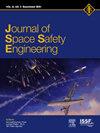Producing compact copper elements in the velocity range of 5–9.5 km/s using shaped charges with modified combined hemisphere-cylinder liners
IF 1.7
Q3 ENGINEERING, AEROSPACE
引用次数: 0
Abstract
To test the protective shields of spacecraft for resistance to meteoroids and space debris fragments, it is necessary to develop methods for accelerating solid particles to high velocities. The currently used shaped charges with a combined hemisphere-cylinder liner make it possible to produce compact steel elements with velocities at the level of 6 km/s. Based on numerical modeling within framework of a two-dimensional axisymmetric problem of continuum mechanics, the possibilities of modifying hemisphere-cylinder liner to expand the range of velocities of the resulting compact elements are considered. Modeling was carried out with respect to a shaped charge with a diameter of 100 mm and a copper liner. The jet-forming part of the liner was given a degressive (decreasing from the top to the base) thickness with a hemispherical or semi-ellipsoidal shape of its outer surface and a semi-ellipsoidal or semi-superellipsoidal shape of the inner surface. By numerical calculations, the geometric parameters of the combined liners were selected, which make it possible to form compact elements with velocities in the range from 5 to 9.5 km/s at the maximum possible value of element mass. The mass of the element at a velocity of about 9.5 km/s was about 5 g.
在5-9.5 km/s的速度范围内,使用改进的半球-圆柱体组合内衬聚能装药生产致密的铜元素
为了测试航天器的防护罩对流星体和空间碎片的抵抗能力,有必要开发固体粒子加速到高速的方法。目前使用的聚能装药与半圆柱体复合衬套使生产速度达到6公里/秒的紧凑钢元件成为可能。基于二维连续介质力学轴对称问题的数值模拟,考虑了对半圆柱衬套进行修正以扩大压缩单元速度范围的可能性。对直径为100 mm的聚能装药和铜衬里进行了建模。射流成形部分的外表面为半椭球或半椭球形状,内表面为半椭球或半超椭球形状,厚度由上至下递减。通过数值计算,选择了组合衬垫的几何参数,使其能够在最大可能质量值下形成速度在5 ~ 9.5 km/s范围内的致密单元。在大约9.5 km/s的速度下,元素的质量约为5 g。
本文章由计算机程序翻译,如有差异,请以英文原文为准。
求助全文
约1分钟内获得全文
求助全文
来源期刊

Journal of Space Safety Engineering
Engineering-Safety, Risk, Reliability and Quality
CiteScore
2.50
自引率
0.00%
发文量
80
 求助内容:
求助内容: 应助结果提醒方式:
应助结果提醒方式:


